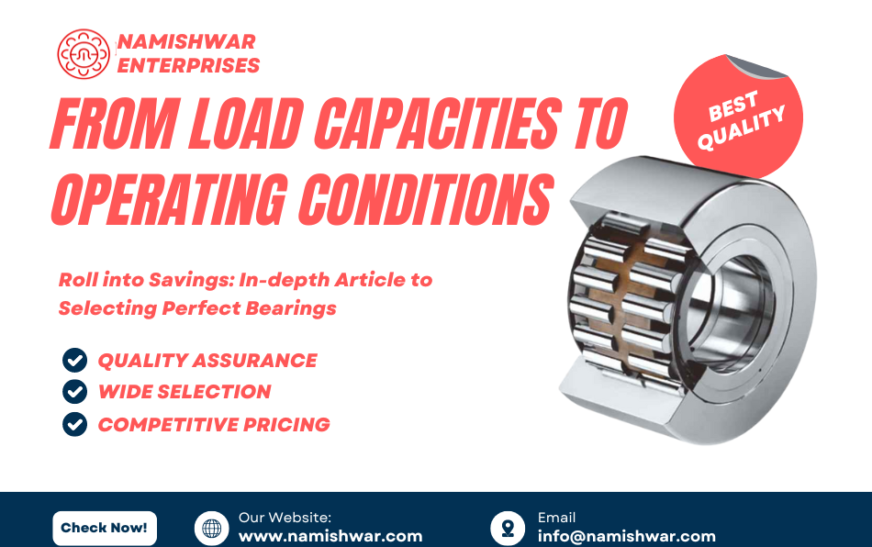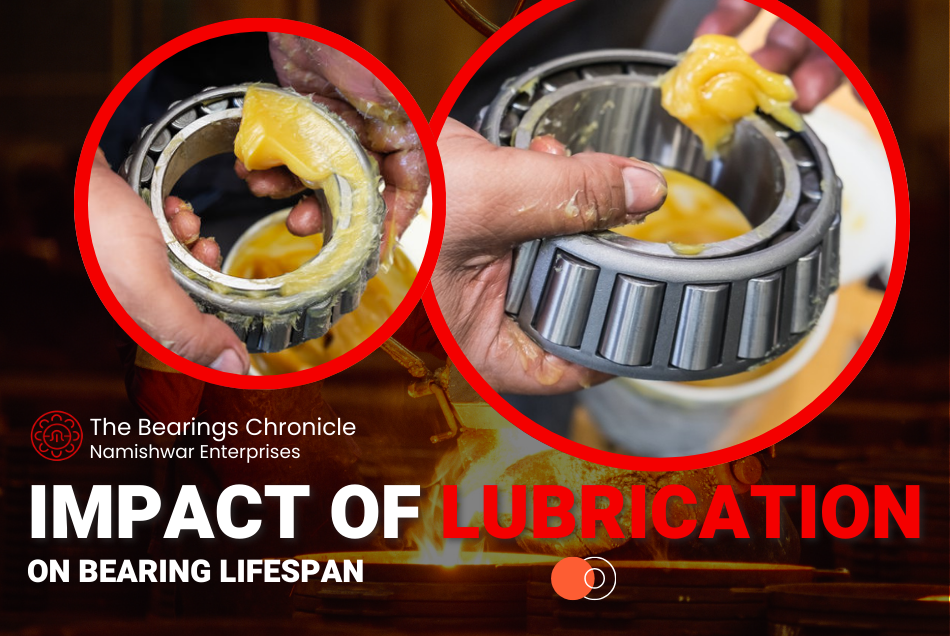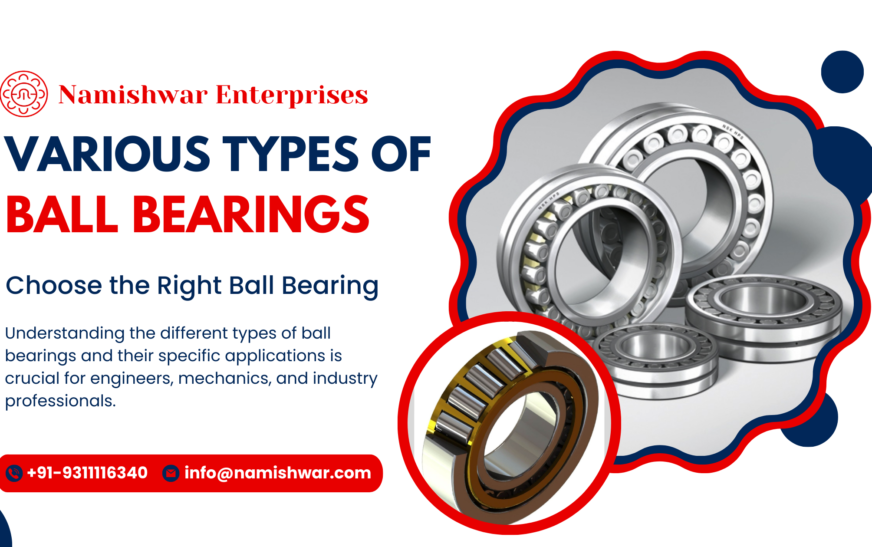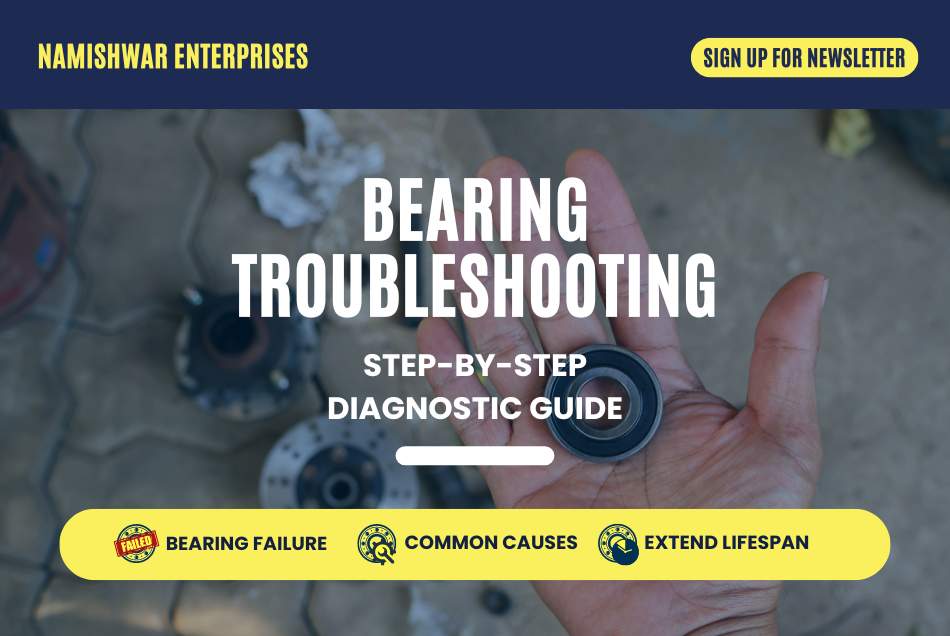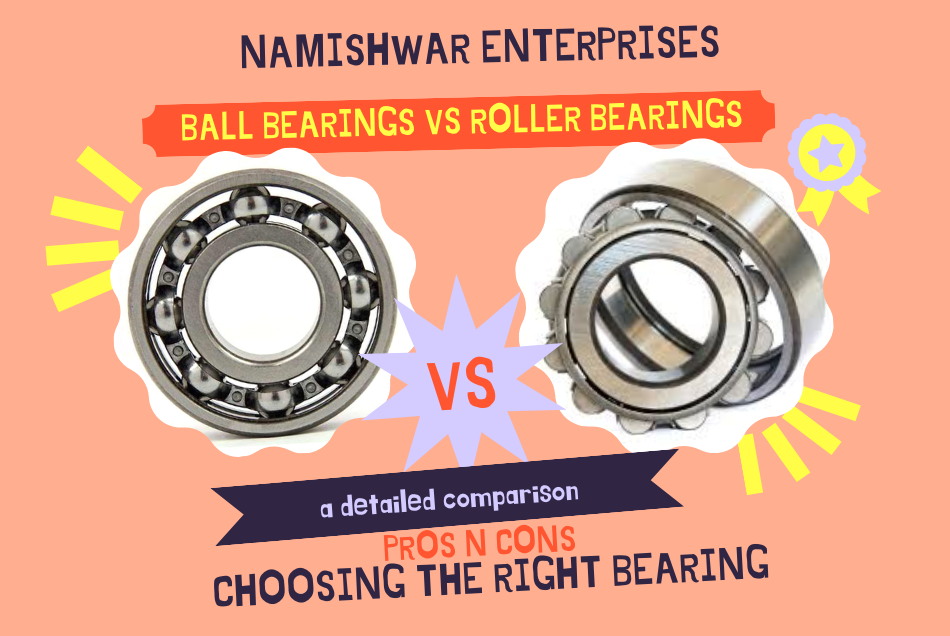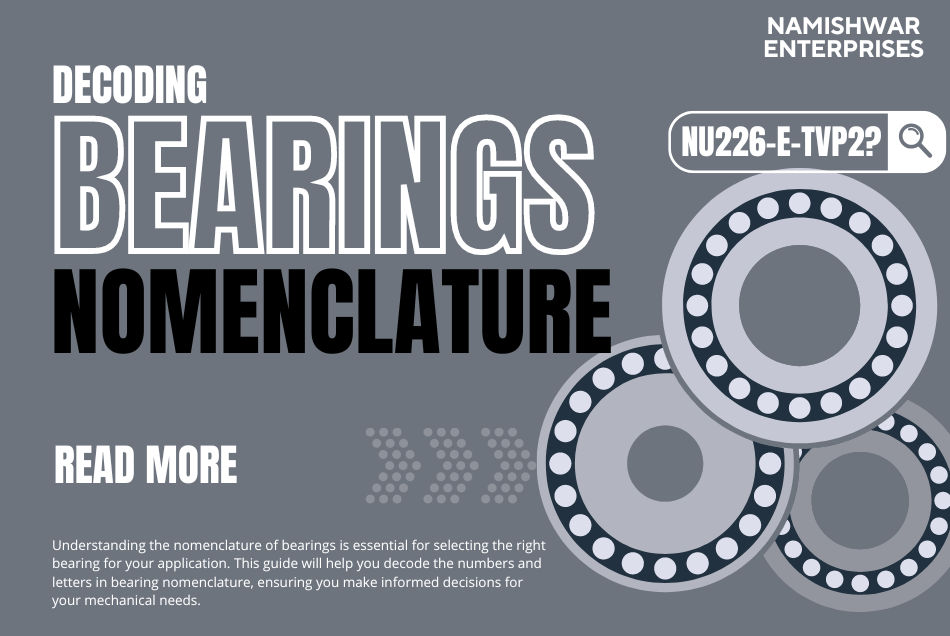Understanding Bearing Types and Their Applications
Selecting the right bearing for a specific application requires understanding the various types of bearings and their unique characteristics. Bearings are designed to support different kinds of loads and operate under various conditions. Here, we will explore the most common bearing types and their primary applications.
Rolling Element Bearings
Rolling element bearings, commonly known as ball and roller bearings, are widely used due to their ability to handle both radial and axial loads. They come in two main categories:
- Ball Bearings: These are the most prevalent type of rolling bearings. They use balls to maintain the separation between bearing races. Ball bearings are ideal for applications with lower load capacities, such as household appliances, automotive applications, and precision instruments.
- Roller Bearings: Unlike ball bearings, roller bearings use cylindrical rollers, which allow them to handle higher load capacities. There are several subtypes, including cylindrical roller bearings, tapered roller bearings, and spherical roller bearings. These are typically used in heavy machinery, conveyor belt rollers, and gearboxes.
Plain Bearings
Plain bearings, also known as sleeve or journal bearings, consist of a simple surface that supports the rotating shaft. They are preferred for their simplicity, cost-effectiveness, and reliability in high-load, low-speed applications. Common uses include automotive engines, turbines, and industrial machinery.
Fluid Bearings
Fluid bearings utilize a thin layer of fluid, such as oil or air, to support the load. The fluid layer reduces friction and wear, making them suitable for high-speed applications. They are commonly found in hard disk drives, turbines, and high-precision instruments.
Magnetic Bearings
Magnetic bearings support the load using magnetic fields, eliminating physical contact and thus friction and wear. They are ideal for applications requiring extremely high speeds and low friction, such as flywheel energy storage systems and advanced medical devices.
Application-Specific Bearings
Specialized bearings are designed for unique applications and conditions. These include:
- Needle Bearings: With their small cylindrical rollers, needle bearings handle high radial loads in compact spaces. They are used in automotive transmissions and power tools.
- Thrust Bearings: Designed to handle axial loads, thrust bearings are found in automotive steering systems and helicopter rotors.
- Self-Aligning Bearings: These bearings can tolerate misalignment between the shaft and housing, making them ideal for agricultural machinery and textile equipment.
Understanding the different types of bearings and their applications is the first step in making an informed selection. Next, we will delve into the key factors to consider when choosing a bearing.
Key Factors in Bearing Selection
Choosing the right bearing involves evaluating several critical factors to ensure optimal performance and longevity. The following are the primary considerations when selecting a bearing for a specific application.
Load Capacity
The load capacity of a bearing is a fundamental consideration. Bearings must support both radial and axial loads without excessive deformation or wear. Load ratings, including dynamic and static load capacities, are provided by manufacturers to help in selecting the appropriate bearing.
- Dynamic Load Capacity: This indicates the bearing’s ability to withstand loads while in motion. It is crucial for applications with continuous or repetitive movements.
- Static Load Capacity: This measures the bearing’s ability to support loads without movement. It is essential for applications where the bearing remains stationary under load for extended periods.
Operating Speed
Bearings must operate efficiently at the required speeds of the application. Different bearings are designed for different speed ranges. For instance, ball bearings are suitable for high-speed applications, while plain bearings are better for low-speed, high-load conditions.
Temperature Range
Bearings must withstand the operating temperature range of the application. High temperatures can degrade bearing materials and lubricants, leading to premature failure. Bearings designed for high-temperature environments often use special materials and lubricants.
Environmental Conditions
The operating environment significantly impacts bearing performance. Considerations include:
- Contamination: Bearings in dirty or abrasive environments require effective sealing to prevent contamination.
- Humidity and Corrosion: Bearings exposed to moisture or corrosive substances need to be corrosion-resistant.
Bearing Life
The expected lifespan of a bearing, known as its fatigue life, is another key factor. Bearing life calculations take into account the load, speed, and operating conditions to estimate how long the bearing will last before requiring replacement.
Lubrication
Proper lubrication is critical for reducing friction and wear. The type and frequency of lubrication depend on the bearing type and operating conditions. Options include grease, oil, and solid lubricants.
Mounting and Maintenance
Ease of installation and maintenance is another consideration. Some bearings require precise alignment and specialized tools for installation. Maintenance requirements, such as lubrication intervals and inspection, should also be factored into the selection process.
By carefully evaluating these factors, engineers can select bearings that will deliver reliable performance and long service life. Next, we will discuss the importance of load calculations in bearing selection.
Load Calculations and Bearing Selection
Accurate load calculations are crucial in the bearing selection process to ensure that the chosen bearing can handle the applied loads without failure. Understanding the types of loads and how to calculate them is essential for optimal bearing performance.
Types of Loads
Bearings are subjected to different types of loads, each affecting their performance and lifespan. The main types of loads are:
- Radial Loads: These act perpendicular to the shaft axis. They are the most common type of load in rotating machinery.
- Axial Loads: Also known as thrust loads, these act parallel to the shaft axis. They are common in applications such as screw jacks and thrust bearings.
- Combined Loads: These involve both radial and axial loads. Many applications, such as automotive wheels, experience combined loads.
Load Calculations
To select the appropriate bearing, accurate load calculations are necessary. The basic steps include:
- Determine the Load Magnitude: Identify the maximum loads the bearing will encounter. Use tools such as force sensors and load cells to measure these loads accurately.
- Calculate Equivalent Load: For applications with combined loads, calculate the equivalent load using the formula:
[P = X \cdot F_r + Y \cdot F_a],
where:
- (P) is the equivalent load.
- (F_r) is the radial load.
- (F_a) is the axial load.
- (X) and (Y) are load factors provided by the bearing manufacturer.
- Dynamic Load Rating: Compare the equivalent load to the bearing’s dynamic load rating (C). The bearing’s expected life is determined using the equation:
[L_{10} = \left( \frac{C}{P} \right)^3]
Where:
- (L_{10}) is the bearing life in millions of revolutions.
- (C) is the dynamic load rating.
- (P) is the equivalent load.
2. Static Load Rating: Ensure that the static load rating (C0) exceeds the maximum static load to prevent permanent deformation.
Load Distribution
In applications with multiple bearings, load distribution must be considered. Uneven load distribution can lead to premature bearing failure. Use load distribution calculations and consider factors such as shaft deflection and misalignment.
Safety Factors
Incorporate safety factors into load calculations to account for unexpected load increases or variations. Safety factors vary depending on the application and industry standards.
Accurate load calculations are essential for selecting bearings that can handle the applied loads without failure. Proper load calculation ensures the longevity and reliability of the bearing in its application. Next, we will explore the impact of operating conditions on bearing selection.
The Impact of Operating Conditions on Bearing Selection
Operating conditions play a significant role in bearing performance and longevity. Factors such as temperature, contamination, vibration, and alignment must be considered when selecting a bearing.
Temperature
Bearings must operate within the temperature range specified for the application. Extreme temperatures can affect bearing materials and lubricants, leading to failure. Consider the following:
- High Temperatures: High temperatures can cause bearing materials to soften and lubricants to degrade. Use bearings with high-temperature ratings and suitable lubricants.
- Low Temperatures: Low temperatures can make materials brittle and increase lubricant viscosity. Select bearings and lubricants designed for low-temperature applications.
Contamination
Contaminants such as dirt, dust, and moisture can significantly impact bearing performance. To protect bearings from contamination:
- Seals and Shields: Use bearings with seals or shields to prevent contaminants from entering.
- Lubrication: Proper lubrication can help flush out contaminants and protect bearing surfaces.
Vibration
Excessive vibration can cause bearing damage and premature failure. To mitigate vibration:
- Vibration Damping: Use vibration-damping materials and techniques to reduce the impact of vibrations.
- Proper Mounting: Ensure bearings are mounted correctly to minimize vibration.
Misalignment
Misalignment between the shaft and housing can lead to uneven load distribution and bearing failure. To address misalignment:
- Self-Aligning Bearings: Use self-aligning bearings that can compensate for misalignment.
- Precision Mounting: Ensure precise alignment during installation.
Load Variations
Bearings must handle load variations without failure. Consider the following:
- Dynamic Loads: Bearings should accommodate dynamic loads that vary in magnitude and direction.
- Shock Loads: Select bearings with high load ratings to handle sudden shock loads.
Speed
The operating speed of the application affects bearing selection. High-speed applications require bearings with low friction
and heat generation, while low-speed applications can use bearings designed for higher load capacities.
Lubrication
Proper lubrication is critical for bearing performance. Consider the following:
- Lubricant Type: Select the appropriate lubricant (grease, oil, or solid) based on the application and operating conditions.
- Lubrication Interval: Determine the lubrication interval to ensure optimal bearing performance.
Environmental Conditions
Environmental factors such as humidity, corrosive substances, and exposure to chemicals can affect bearing performance. Use bearings with appropriate materials and coatings to resist environmental damage.
By considering the impact of operating conditions, engineers can select bearings that will perform reliably under the specific conditions of their application. Next, we will discuss the importance of bearing materials and coatings in bearing selection.
Bearing Materials and Coatings
The choice of materials and coatings for bearings is critical for ensuring optimal performance and longevity. Different applications and operating conditions require bearings made from specific materials and with suitable coatings to withstand various challenges.
Bearing Materials
The material used in bearing construction significantly affects its performance characteristics. Common bearing materials include:
- Steel: The most common material for bearings, steel offers excellent strength, durability, and cost-effectiveness. Types include:
- Carbon Steel: Suitable for general-purpose applications.
- Stainless Steel: Provides corrosion resistance for applications in humid or chemically aggressive environments.
- Ceramics: Ceramic bearings are lightweight and resistant to high temperatures and corrosion. They are ideal for high-speed and high-temperature applications but are more expensive than steel bearings.
- Polymers: Bearings made from high-performance plastics offer low friction and good chemical resistance. They are used in applications requiring lightweight and corrosion-resistant properties, such as food processing and medical devices.
- Composite Materials: These bearings combine different materials to offer specific performance characteristics, such as low weight, high strength, and corrosion resistance.
Bearing Coatings
Coatings enhance the performance and lifespan of bearings by providing additional protection against wear, corrosion, and friction. Common bearing coatings include:
- Anti-Corrosion Coatings: Protect bearings from rust and corrosion in harsh environments. Common coatings include zinc, nickel, and chromium.
- Anti-Friction Coatings: Reduce friction and wear, improving bearing efficiency and lifespan. Examples include PTFE (Teflon) and molybdenum disulfide coatings.
- Hard Coatings: Increase surface hardness to resist wear and extend bearing life. Diamond-like carbon (DLC) coatings are an example.
Application-Specific Considerations
When selecting bearing materials and coatings, consider the specific requirements of the application:
- Load Capacity: Materials must handle the applied loads without excessive deformation or wear.
- Temperature Range: Bearings must withstand the operating temperatures of the application without degradation.
- Corrosion Resistance: For applications in corrosive environments, select materials and coatings that resist chemical attack.
- Friction and Wear: Choose materials and coatings that reduce friction and wear to enhance performance and longevity.
- Weight: In applications where weight is a critical factor, such as aerospace and robotics, select lightweight materials like ceramics or polymers.
By carefully selecting the appropriate materials and coatings, engineers can ensure that bearings perform reliably under the specific conditions of their application. Next, we will explore the role of lubrication in bearing performance.
The Role of Lubrication in Bearing Performance
Lubrication is critical for the performance and longevity of bearings. Proper lubrication reduces friction, prevents wear, and protects against contaminants. The choice of lubricant and lubrication method depends on the bearing type and operating conditions.
Types of Lubricants
Different types of lubricants are used in bearings, each with specific properties:
- Grease: A common lubricant for bearings, grease consists of a base oil, thickener, and additives. It provides good sealing and is easy to apply. Grease is suitable for most general-purpose applications.
- Oil: Oil lubricants offer better cooling and lower friction than grease. They are used in high-speed and high-temperature applications. Oil can be applied through oil baths, circulating systems, or oil mist.
- Solid Lubricants: Solid lubricants such as graphite and molybdenum disulfide are used in applications where liquid lubricants are impractical. They provide long-lasting lubrication and are ideal for high-temperature and vacuum environments.
Lubrication Methods
The method of applying lubrication affects bearing performance. Common methods include:
- Manual Lubrication: Applying lubricant by hand is suitable for low-maintenance and low-speed applications. It requires regular intervals to ensure adequate lubrication.
- Automatic Lubrication: Automated systems deliver precise amounts of lubricant at regular intervals. They are ideal for high-speed, high-load, and hard-to-reach applications.
- Centralized Lubrication: A central system supplies lubricant to multiple bearings through a network of pipes. It ensures consistent lubrication and is suitable for large machinery and industrial plants.
Lubrication Interval
The frequency of lubrication depends on the bearing type, lubricant, and operating conditions. Regular lubrication prevents friction and wear, ensuring optimal performance and longevity. Factors affecting lubrication intervals include:
- Load and Speed: Higher loads and speeds increase the need for frequent lubrication.
- Temperature: High temperatures accelerate lubricant degradation, requiring more frequent lubrication.
- Contamination: Bearings in dirty or abrasive environments need regular lubrication to flush out contaminants.
Lubricant Properties
Selecting the right lubricant involves considering its properties:
- Viscosity: The lubricant’s resistance to flow affects its ability to reduce friction and wear. Higher viscosity lubricants provide better load-carrying capacity, while lower viscosity lubricants offer better cooling and speed.
- Additives: Lubricants may contain additives to enhance their performance, such as anti-wear agents, corrosion inhibitors, and extreme pressure additives.
- Compatibility: Ensure the lubricant is compatible with bearing materials and seals to prevent degradation.
Monitoring and Maintenance
Regular monitoring and maintenance are essential for effective lubrication. Techniques include:
- Visual Inspection: Check lubricant levels and condition regularly.
- Condition Monitoring: Use sensors and diagnostic tools to monitor bearing and lubricant condition, such as temperature, vibration, and wear particles.
Proper lubrication is crucial for bearing performance and longevity. By selecting the right lubricant and lubrication method, and maintaining regular intervals, engineers can ensure reliable bearing operation. Next, we will discuss the importance of bearing maintenance and monitoring.
Bearing Maintenance and Monitoring
Regular maintenance and monitoring are essential for ensuring bearing performance and preventing unexpected failures. Effective maintenance practices extend bearing life and reduce downtime, while monitoring techniques help detect early signs of wear and damage.
Maintenance Practices
Proper maintenance practices are crucial for bearing longevity. Key practices include:
- Regular Inspection: Inspect bearings regularly for signs of wear, damage, and contamination. Look for abnormal noise, vibration, and temperature changes.
- Lubrication: Ensure bearings are properly lubricated at regular intervals. Check lubricant levels and condition, and replenish or replace as needed.
- Cleaning: Keep bearings and surrounding areas clean to prevent contamination. Use appropriate cleaning methods and solvents.
- Alignment: Ensure proper alignment of shafts and housings to prevent misalignment and uneven load distribution.
- Handling and Storage: Handle bearings with care to avoid damage. Store bearings in a clean, dry environment to prevent corrosion and contamination.
Monitoring Techniques
Monitoring techniques help detect early signs of bearing wear and damage, allowing for timely maintenance and preventing unexpected failures. Common monitoring techniques include:
- Vibration Analysis: Vibration sensors detect changes in vibration patterns, indicating potential bearing issues. Analyze vibration data to identify the source and severity of the problem.
- Temperature Monitoring: Temperature sensors detect abnormal temperature increases, which can indicate lubrication issues, excessive load, or bearing wear.
- Acoustic Emission: Acoustic sensors detect high-frequency sound waves emitted by bearing surfaces. Changes in acoustic emission can indicate early signs of wear and damage.
- Oil Analysis: Analyze lubricant samples for wear particles, contaminants, and chemical changes. Oil analysis helps identify bearing wear and lubrication issues.
- Ultrasound: Ultrasound sensors detect high-frequency sounds produced by bearing defects. Ultrasound can identify early-stage bearing issues before they become severe.
Predictive Maintenance
Predictive maintenance uses monitoring data to predict bearing failures and schedule maintenance before issues become critical. Techniques include:
- Condition Monitoring: Continuously monitor bearing condition using sensors and diagnostic tools. Analyze data to predict bearing wear and schedule maintenance.
- Prognostics: Use advanced algorithms and machine learning to analyze monitoring data and predict remaining bearing life. Implement maintenance schedules based on prognostic predictions.
Benefits of Maintenance and Monitoring
Regular maintenance and monitoring offer several benefits:
- Extended Bearing Life: Proper maintenance practices extend bearing life and reduce replacement costs.
- Reduced Downtime: Timely maintenance prevents unexpected bearing failures and reduces downtime.
- Improved Performance: Well-maintained bearings perform more efficiently, reducing energy consumption and operating costs.
- Early Detection: Monitoring techniques detect early signs of wear and damage, allowing for timely maintenance and preventing severe issues.
By implementing effective maintenance and monitoring practices, engineers can ensure optimal bearing performance and prevent unexpected failures. Next, we will discuss the importance of bearing installation and alignment.
Bearing Installation and Alignment
Proper installation and alignment are critical for bearing performance and longevity. Incorrect installation and misalignment can lead to premature bearing failure, increased wear, and reduced efficiency. Following best practices for installation and alignment ensures reliable bearing operation.
Bearing Installation
The installation process involves several steps to ensure proper fit and function:
- Preparation: Clean the bearing and surrounding components to remove contaminants
. Ensure all tools and equipment are ready for installation.
- Inspection: Inspect the bearing and housing for any damage or defects. Replace any damaged components before installation.
- Handling: Handle bearings with care to avoid damage. Use appropriate tools and techniques to avoid applying excessive force.
- Mounting: Use proper mounting techniques to ensure a secure fit. Common methods include:
- Cold Mounting: Press-fit bearings using manual or hydraulic presses. Ensure even pressure to avoid damaging the bearing.
- Hot Mounting: Heat the bearing or housing to expand the material for easier installation. Use temperature-controlled heating methods to avoid overheating.
- Interference Fit: Use interference fits to secure the bearing in the housing. Ensure proper tolerances to avoid excessive stress on the bearing.
Bearing Alignment
Proper alignment ensures even load distribution and prevents premature wear. Key alignment techniques include:
- Shaft Alignment: Ensure the shaft is aligned with the bearing housing to prevent misalignment. Use alignment tools such as dial indicators, laser alignment systems, and straight edges.
- Angular Alignment: Check for angular misalignment between the shaft and housing. Adjust as needed to ensure proper alignment.
- Parallel Alignment: Ensure the shaft is parallel to the housing to prevent misalignment. Use alignment tools to check and adjust as needed.
- Radial and Axial Alignment: Ensure proper radial and axial alignment to prevent uneven load distribution. Use alignment tools to check and adjust as needed.
Post-Installation Checks
After installation and alignment, perform post-installation checks to ensure proper function:
- Run-In Period: Allow a run-in period to check for any issues. Monitor the bearing for abnormal noise, vibration, and temperature changes.
- Final Inspection: Perform a final inspection to check for proper installation and alignment. Ensure all components are secure and functioning correctly.
- Documentation: Document the installation and alignment process, including any issues and adjustments made. This information is useful for future maintenance and troubleshooting.
Common Installation Issues
Common installation issues that can affect bearing performance include:
- Misalignment: Improper alignment can lead to uneven load distribution and premature wear. Ensure proper alignment during installation.
- Contamination: Contaminants can cause bearing damage and reduce lifespan. Ensure a clean installation environment.
- Overheating: Excessive heating during installation can damage bearing materials. Use controlled heating methods to avoid overheating.
- Incorrect Fit: An incorrect fit can cause excessive stress on the bearing. Ensure proper tolerances and fit during installation.
By following best practices for bearing installation and alignment, engineers can ensure reliable bearing performance and prevent premature failure. Next, we will summarize the key points discussed in this article.
Table Summarizing Bearing Selection and Maintenance
| Topic | Key Points |
|---|---|
| Bearing Types | Ball, roller, plain, fluid, magnetic, needle, thrust, self-aligning |
| Key Factors | Load capacity, operating speed, temperature range, environmental conditions, lubrication |
| Load Calculations | Types of loads, load magnitude, equivalent load, dynamic and static load ratings, safety factors |
| Operating Conditions | Temperature, contamination, vibration, misalignment, load variations, speed, lubrication |
| Materials and Coatings | Steel, ceramics, polymers, composite materials, anti-corrosion, anti-friction, hard coatings |
| Lubrication | Types of lubricants (grease, oil, solid), lubrication methods, lubrication interval, properties |
| Maintenance and Monitoring | Regular inspection, lubrication, cleaning, alignment, handling, vibration analysis, temperature monitoring, acoustic emission, oil analysis, ultrasound |
| Installation and Alignment | Preparation, inspection, handling, mounting, alignment techniques, post-installation checks, common issues |
FAQ
What are the most common types of bearings?
The most common types of bearings are ball bearings, roller bearings, plain bearings, fluid bearings, and magnetic bearings. Each type has unique characteristics suited for specific applications.
How do you determine the load capacity of a bearing?
The load capacity of a bearing is determined by its dynamic and static load ratings. Dynamic load capacity indicates the bearing’s ability to handle loads while in motion, while static load capacity measures its ability to support loads without movement.
Why is lubrication important for bearings?
Lubrication is essential for reducing friction, preventing wear, and protecting bearings from contaminants. Proper lubrication ensures optimal performance and extends bearing life.
How do operating conditions affect bearing selection?
Operating conditions such as temperature, contamination, vibration, and alignment significantly impact bearing performance. Bearings must be selected to withstand the specific conditions of the application.
What materials are used in bearings?
Common bearing materials include steel, ceramics, polymers, and composite materials. The choice of material depends on the application’s load capacity, temperature range, corrosion resistance, and other requirements.
What are the benefits of bearing maintenance and monitoring?
Regular maintenance and monitoring extend bearing life, reduce downtime, improve performance, and allow for early detection of wear and damage, preventing severe issues.
How do you ensure proper bearing installation and alignment?
Proper bearing installation involves preparation, inspection, handling, and mounting using appropriate techniques. Alignment ensures even load distribution and prevents premature wear. Post-installation checks verify proper function.

